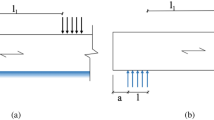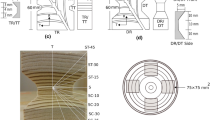Abstract
The mechanical behaviour of timber loaded in compression perpendicular to grain is essential for a rational design of many timber structures. Structural components frequently exposed to such loading include studs on bottom rails, stress-laminated timber decks, timber elements lying in between vertical load-bearing columns as well as traditional timber joints mating surfaces in compression. Compression perpendicular to grain has been a repeated topic for discussion both in the current European regulations for timber structures, as well as in the ongoing work with the next generation of Eurocode 5-timber structures. However, the long-term behaviour is quite complex, taking both time and moisture variation into consideration, and to improve the understanding and the ability to consider the long-term effects in practical design, a simplified one-dimensional model is given herein. The paper presents novel results from long-term compression orthogonal to grain tests performed with load and moisture control. The purpose of the testing was to evaluate the effect of transversal creep on the long-term behaviour of timber elements including the effect of the mechanosorptive deformation. The test results were in turn used to calibrate a one-dimensional model for the prediction of the long-term response of timber. The model takes into account the combined effects of loading and moisture variations. The effective material properties are defined by use of effective pith locations together with the orthotropic material parameters. Finally, a comparison between the model results and experimental observations is given, showing an overall good prediction of the response.









Similar content being viewed by others
References
Anderberg Y (1988) Modelling Steel Behaviour. Fire Saf J 13:17–26
Angst V, Malo KA (2010) Moisture induced stresses perpendicular to the grain in glulam: review and evaluation of the relative importance of models and parameters. Holzforschung 64:609–617
Angst V, Malo KA (2012) The effect of climate variations on glulam—an experimental study. Eur J Wood Prod 70:603–613
Angst V, Malo KA (2013) Moisture-induced stresses in glulam cross sections during wetting exposures. Wood Sci Technol 47:227–241
Avramidis S (1989) Evaluation of “three-variable” models for the prediction of equilibrium moisture content in wood. Wood Sci Technol 23:251–257
Bengtsson C (1999) Mechano-sorptive creep in wood—experimental studies of the influence of material properties. Dissertation, Chalmers University of Technology
Bodig J, Jayne BA (1993) Mechanics of wood and wood composites. Krieger Publishing Company, Malabar, USA
COMSOL Inc. (2017) COMSOL Multiphysics 5.3
Dahl KB (2009) Mechanical properties of clear wood from Norway spruce. Doctoral dissertation, Norwegian University of Science and Technology
Dahl KB, Malo KA (2009) Linear shear properties of spruce softwood. Wood Sci Technol 43:499–525. https://doi.org/10.1007/s00226-009-0246-5
Dahl KB, Bovim NI, Malo KA (2006) Evaluation of stress laminated bridge decks based on full scale tests. In: Paper presented at the 9th world conference on timber engineering, Portland
Dassault Systemes (2014) Abaqus/CAE 6.14. Vélizy-Villacoublay, France
Dassault Systemes (2017) Isight. Vélizy-Villacoublay, France
Dinwoodie JM (2000) Timber: its nature and behaviour, 2nd edn. E & FN Spon, Taylor & Francis, London, New York
Ekholm K (2013) Performance of stress-laminated timber bridge decks. Doctoral dissertation, Chalmers University of Technology
Fortino S, Mirianon F, Toratti T (2009) A 3D moisture-stress FEM analysis for time dependent problems in timber structures. Mech Time Depend Mater 13:333–356
Häglund M (2010) Parameter influence on moisture induced eigen-stresses in timber. Eur J Wood Prod 68:397–406
Hunt DG (1989) Linearity and non-linearity in mechano-sorptive creep of softwood in compression and bending. Wood Sci Technol 23:323–333. https://doi.org/10.1007/bf00353248
Hunt DG, Shelton CF (1988) Longitudinal moisture-shrinkage coefficients of softwood at the mechano-sorptive creep limit. Wood Sci Technol 22:199–210
Massaro FM, Malo KA (2017) Anchor plates for pre-stressing rods and compression orthogonal to grain of timber. In: Paper presented at the 3rd international conference on timber bridges—ICTB 2017, Skellefteå, Sweden, 26–29 June 2017
MathWorks (2017) MATLAB vol R2017a. Natick, MA, USA
Mohager S, Toratti T (1993) Long term bending creep of wood in cyclic relative humidity. Wood Sci Technol 27:49–59. https://doi.org/10.1007/bf00203409
Morlier P, Palka LC (1994) Basic knowledge. In: Morlier P (ed) RILEM report 8—creep in timber structures. E & FN Spon, London, pp 9–42
Muszyński L, Lagaňa R, Shaler SM, Davids WG (2005) Comments on the experimental methodology for determination of the hygro-mechanical properties of wood. Holzforschung 59:232–239
Ozyhar T, Hering S, Niemz P (2013) Viscoelastic characterization of wood: time dependence of the orthotropic compliance in tension and compression. J Rheol 57:699–717. https://doi.org/10.1122/1.4790170
Pousette A, Jacobsson P, Gustafsson M, Horttanainen J, Dahl K (2002) Stress laminated bridge decks, part II. Trätek, Skellefteå
Pousette A, Massaro FM, Malo KA, Fortino S, Salokangas L, Wacker J (2017) Wooden bridge decks. In: Pousette A, Malo KA, Thelandersson S, Fortino S, Salokangas L, Wacker J (eds) Durable timber bridges—final report and guidelines (SP Rapport). RISE Research Institute of Sweden, Skellefteå, pp 111–132
Ranta-Maunus A (1993) Rheological behaviour of wood in directions perpendicular to the grain. Mater Struct 26:362–369
Reichel S, Kaliske M (2015) Hygro-mehcanically coupled modelling of creep in wooden structures, part I: mechanics. Int J Solids Struct 77:45–64. https://doi.org/10.1016/j.ijsolstr.2015.07.019
Ritter MA (1992) Timber bridges: design, construction, inspection, and maintenance. U.S. Department of Agriculture, Forest Service, Washington DC
Santaoja K, Leino T, Ranta-Maunus A, Hanhijärvi A (1991) Mechano-sorptive structural analysis of wood by the ABAQUS Finite Element Program, vol 1276. VTT Technical Research Centre of Finland—Research Notes, VTT, Espoo
Schneider R, Lange J (2011) Constitutive equations and empirical creep law of structural steel S460 at high temperatures. J Struct Fire Eng 2:217–230
Schniewind AP (1968) Recent progress in the study of the rheology of wood. Wood Sci Technol 2:188–206. https://doi.org/10.1007/BF00350908
Sjödin J (2006) Steel-to-timber dowel joints: Influence of moisture induced stresses. Doctoral Dissertation, Vaxjo University
Svensson S, Toratti T (2002) Mechanical response of wood perpendicular to grain when subjected to changes of humidity. Wood Sci Technol 36:145–156. https://doi.org/10.1007/s00226-001-0130-4
Toratti T (1992) Creep of timber beams in a variable environment. Doctoral Dissertation, Helsinki University of Technology
Acknowledgements
This work was funded by the WoodWisdom-Net+ project DuraTB (“Durable Timber Bridges”) and the support from the funding bodies and partners is gratefully acknowledged.
Author information
Authors and Affiliations
Corresponding author
Ethics declarations
Conflict of interest
On behalf of all authors, the corresponding author states that there is no conflict of interest.
Additional information
Publisher's Note
Springer Nature remains neutral with regard to jurisdictional claims in published maps and institutional affiliations.
Electronic supplementary material
Below is the link to the electronic supplementary material.
Rights and permissions
About this article
Cite this article
Massaro, F.M., Malo, K.A. Long-term behaviour of Norway spruce glulam loaded perpendicular to grain. Eur. J. Wood Prod. 77, 821–832 (2019). https://doi.org/10.1007/s00107-019-01437-4
Received:
Published:
Issue Date:
DOI: https://doi.org/10.1007/s00107-019-01437-4




